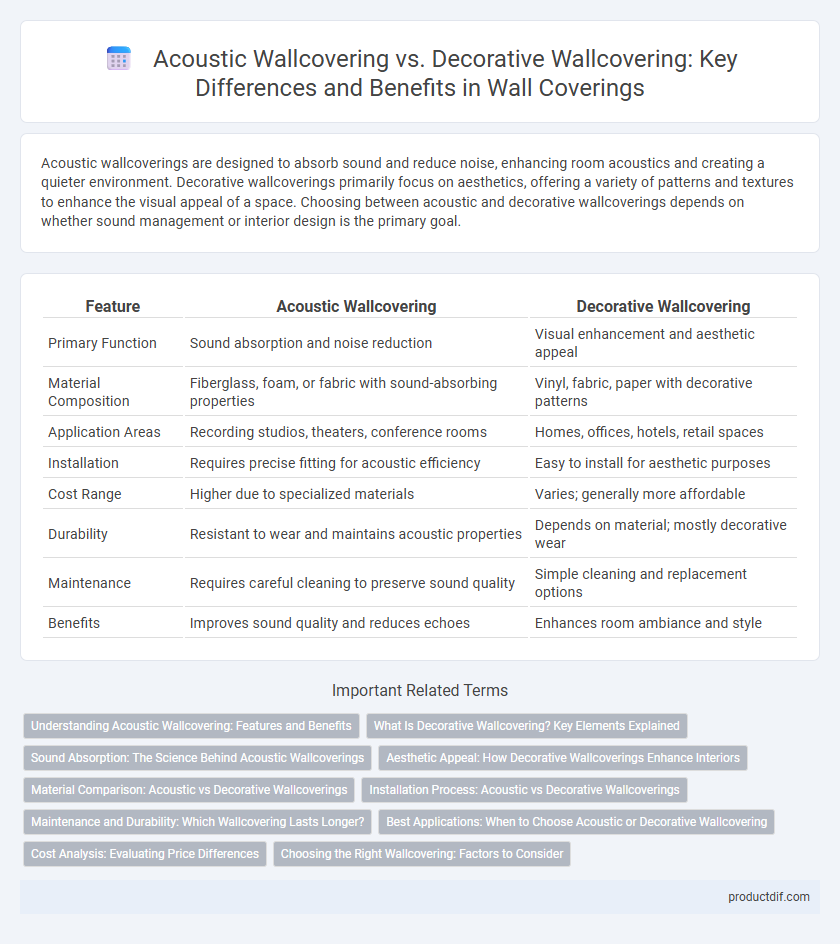Acoustic wallcoverings are designed to absorb sound and reduce noise, enhancing room acoustics and creating a quieter environment. Decorative wallcoverings primarily focus on aesthetics, offering a variety of patterns and textures to enhance the visual appeal of a space. Choosing between acoustic and decorative wallcoverings depends on whether sound management or interior design is the primary goal.
Table of Comparison
| Feature | Acoustic Wallcovering | Decorative Wallcovering |
|---|---|---|
| Primary Function | Sound absorption and noise reduction | Visual enhancement and aesthetic appeal |
| Material Composition | Fiberglass, foam, or fabric with sound-absorbing properties | Vinyl, fabric, paper with decorative patterns |
| Application Areas | Recording studios, theaters, conference rooms | Homes, offices, hotels, retail spaces |
| Installation | Requires precise fitting for acoustic efficiency | Easy to install for aesthetic purposes |
| Cost Range | Higher due to specialized materials | Varies; generally more affordable |
| Durability | Resistant to wear and maintains acoustic properties | Depends on material; mostly decorative wear |
| Maintenance | Requires careful cleaning to preserve sound quality | Simple cleaning and replacement options |
| Benefits | Improves sound quality and reduces echoes | Enhances room ambiance and style |
Understanding Acoustic Wallcovering: Features and Benefits
Acoustic wallcoverings are designed with specialized materials that absorb sound waves, significantly reducing noise levels and enhancing room acoustics. These wallcoverings often incorporate foam, fabric, or composite layers that improve speech clarity and minimize echoes, making them ideal for office spaces, theaters, and conference rooms. Unlike decorative wallcoverings, their primary function is acoustic performance, combining soundproofing benefits with aesthetic appeal to create both functional and visually pleasing interiors.
What Is Decorative Wallcovering? Key Elements Explained
Decorative wallcovering enhances interior aesthetics through diverse patterns, textures, and colors, transforming plain walls into visually engaging surfaces. Key elements include design variety, material quality, and installation techniques that ensure durability and style harmony within any space. Unlike acoustic wallcovering that prioritizes sound absorption, decorative wallcovering focuses on visual appeal and thematic expression.
Sound Absorption: The Science Behind Acoustic Wallcoverings
Acoustic wallcoverings are engineered with sound-absorbing materials like foam, fabric, or perforated composites to reduce echo and enhance room acoustics by minimizing sound reflection. These materials work by converting sound waves into small amounts of heat energy, effectively dampening noise and improving speech clarity in spaces such as offices or theaters. In contrast, decorative wallcoverings prioritize aesthetics without significant sound absorption properties, making acoustic wallcoverings essential for environments demanding controlled noise levels.
Aesthetic Appeal: How Decorative Wallcoverings Enhance Interiors
Decorative wallcoverings significantly elevate interior aesthetics by introducing a variety of textures, patterns, and colors that complement design themes and create focal points in any space. Unlike acoustic wallcoverings, which primarily focus on sound absorption, decorative options transform plain walls into visually engaging surfaces that enhance mood and style. Their versatility allows for customization that aligns with contemporary, classic, or eclectic decor, making interiors more inviting and personalized.
Material Comparison: Acoustic vs Decorative Wallcoverings
Acoustic wallcoverings utilize materials such as foam, fabric, or specialized composites designed to absorb sound waves and reduce noise levels, enhancing room acoustics. Decorative wallcoverings typically employ vinyl, paper, or natural fibers that prioritize aesthetic appeal and surface texture without significant sound absorption properties. The key material difference lies in acoustic wallcoverings' functional composition aimed at sound dampening, whereas decorative options focus mainly on visual enhancement.
Installation Process: Acoustic vs Decorative Wallcoverings
Acoustic wallcoverings require precise installation involving soundproofing materials and seam sealing to ensure optimal noise reduction, often necessitating professional expertise. Decorative wallcoverings are generally easier to install, focusing primarily on surface adhesion and pattern alignment without specialized soundproofing techniques. Proper installation of acoustic wallcoverings significantly impacts their effectiveness in reducing ambient noise compared to the more straightforward application process of decorative options.
Maintenance and Durability: Which Wallcovering Lasts Longer?
Acoustic wallcoverings, often made from dense materials like fabric and foam composites, offer superior durability and are resistant to wear, stains, and moisture, making them easier to maintain in high-traffic or humid environments. Decorative wallcoverings, typically crafted from vinyl or paper, provide aesthetic appeal but often require more frequent cleaning and replacement due to susceptibility to scratches, fading, and damage from moisture. In terms of longevity, acoustic wallcoverings generally last longer and retain their functional and visual qualities better under regular use, especially in commercial or busy residential spaces.
Best Applications: When to Choose Acoustic or Decorative Wallcovering
Acoustic wallcoverings are ideal for environments requiring noise reduction and improved sound quality, such as recording studios, conference rooms, and home theaters. Decorative wallcoverings suit spaces where aesthetic appeal and design flexibility are paramount, including living rooms, hotel lobbies, and retail stores. Selecting between acoustic and decorative wallcoverings depends on balancing sound control needs with visual impact to achieve functional and stylish interiors.
Cost Analysis: Evaluating Price Differences
Acoustic wallcoverings typically incur higher costs due to specialized materials designed to absorb sound and improve room acoustics, such as foam, fabric, or perforated panels, whereas decorative wallcoverings primarily use vinyl, paper, or textile materials focused on aesthetics. Installation expenses for acoustic wallcoverings can also be greater because of the need for precise placement and additional support structures to optimize acoustic performance. Budgeting for wall treatments requires factoring in these material and labor cost variations to make an informed decision aligned with both soundproofing goals and interior design preferences.
Choosing the Right Wallcovering: Factors to Consider
When selecting between acoustic wallcovering and decorative wallcovering, consider factors such as sound absorption needs, aesthetic goals, and room function. Acoustic wallcoverings enhance sound quality and reduce noise, making them ideal for offices, theaters, or home studios, while decorative wallcoverings prioritize visual appeal and texture. Material durability, installation ease, and maintenance requirements also influence the choice to ensure long-term performance and style compatibility.
Acoustic Wallcovering vs Decorative Wallcovering Infographic

 productdif.com
productdif.com